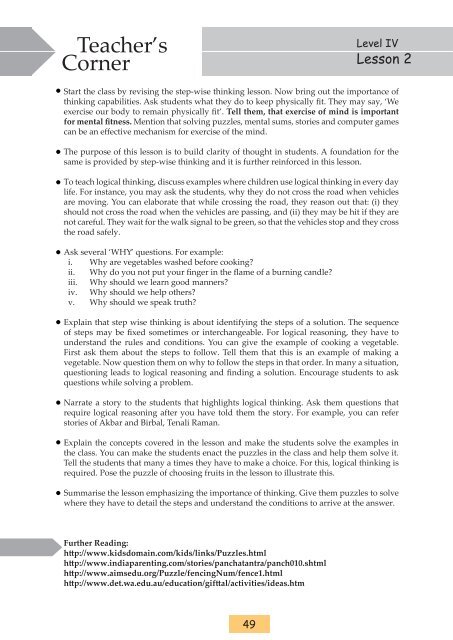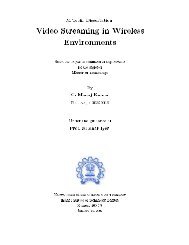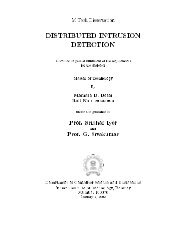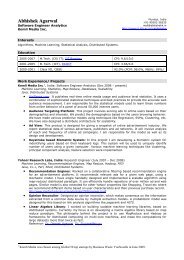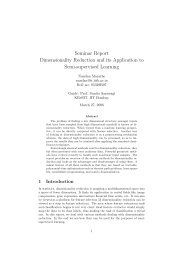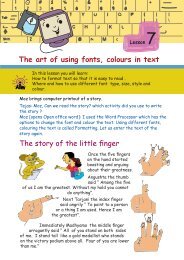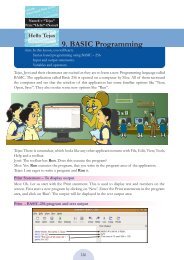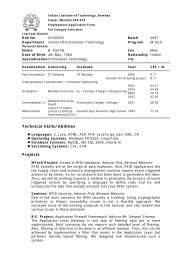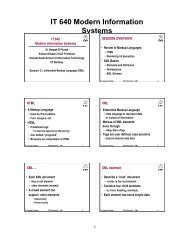worksheets - Indian Institute of Technology, Bombay
worksheets - Indian Institute of Technology, Bombay
worksheets - Indian Institute of Technology, Bombay
You also want an ePaper? Increase the reach of your titles
YUMPU automatically turns print PDFs into web optimized ePapers that Google loves.
Teacher’s<br />
Corner<br />
Level IV<br />
Lesson 2<br />
Start the class by revising the step-wise thinking lesson. Now bring out the importance <strong>of</strong><br />
thinking capabilities. Ask students what they do to keep physically fit. They may say, ‘We<br />
exercise our body to remain physically fit’. Tell them, that exercise <strong>of</strong> mind is important<br />
for mental fitness. Mention that solving puzzles, mental sums, stories and computer games<br />
can be an effective mechanism for exercise <strong>of</strong> the mind.<br />
The purpose <strong>of</strong> this lesson is to build clarity <strong>of</strong> thought in students. A foundation for the<br />
same is provided by step-wise thinking and it is further reinforced in this lesson.<br />
To teach logical thinking, discuss examples where children use logical thinking in every day<br />
life. For instance, you may ask the students, why they do not cross the road when vehicles<br />
are moving. You can elaborate that while crossing the road, they reason out that: (i) they<br />
should not cross the road when the vehicles are passing, and (ii) they may be hit if they are<br />
not careful. They wait for the walk signal to be green, so that the vehicles stop and they cross<br />
the road safely.<br />
Ask several ‘WHY’ questions. For example:<br />
i. Why are vegetables washed before cooking?<br />
ii. Why do you not put your finger in the flame <strong>of</strong> a burning candle?<br />
iii. Why should we learn good manners?<br />
iv. Why should we help others?<br />
v. Why should we speak truth?<br />
Explain that step wise thinking is about identifying the steps <strong>of</strong> a solution. The sequence<br />
<strong>of</strong> steps may be fixed sometimes or interchangeable. For logical reasoning, they have to<br />
understand the rules and conditions. You can give the example <strong>of</strong> cooking a vegetable.<br />
First ask them about the steps to follow. Tell them that this is an example <strong>of</strong> making a<br />
vegetable. Now question them on why to follow the steps in that order. In many a situation,<br />
questioning leads to logical reasoning and finding a solution. Encourage students to ask<br />
questions while solving a problem.<br />
Narrate a story to the students that highlights logical thinking. Ask them questions that<br />
require logical reasoning after you have told them the story. For example, you can refer<br />
stories <strong>of</strong> Akbar and Birbal, Tenali Raman.<br />
Explain the concepts covered in the lesson and make the students solve the examples in<br />
the class. You can make the students enact the puzzles in the class and help them solve it.<br />
Tell the students that many a times they have to make a choice. For this, logical thinking is<br />
required. Pose the puzzle <strong>of</strong> choosing fruits in the lesson to illustrate this.<br />
Summarise the lesson emphasizing the importance <strong>of</strong> thinking. Give them puzzles to solve<br />
where they have to detail the steps and understand the conditions to arrive at the answer.<br />
Further Reading:<br />
http://www.kidsdomain.com/kids/links/Puzzles.html<br />
http://www.indiaparenting.com/stories/panchatantra/panch010.shtml<br />
http://www.aimsedu.org/Puzzle/fencingNum/fence1.html<br />
http://www.det.wa.edu.au/education/gifttal/activities/ideas.htm<br />
49


